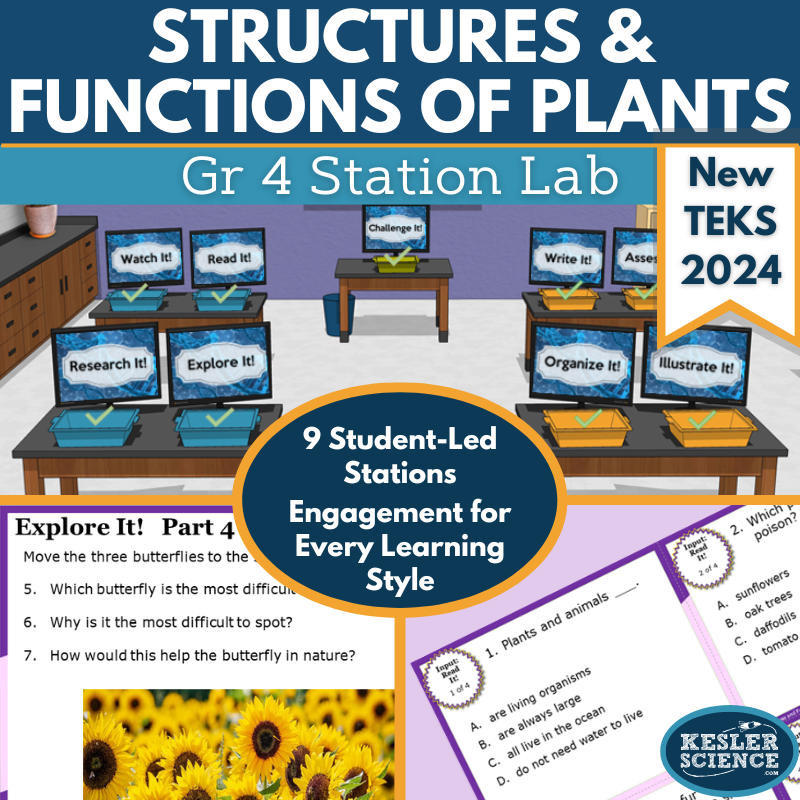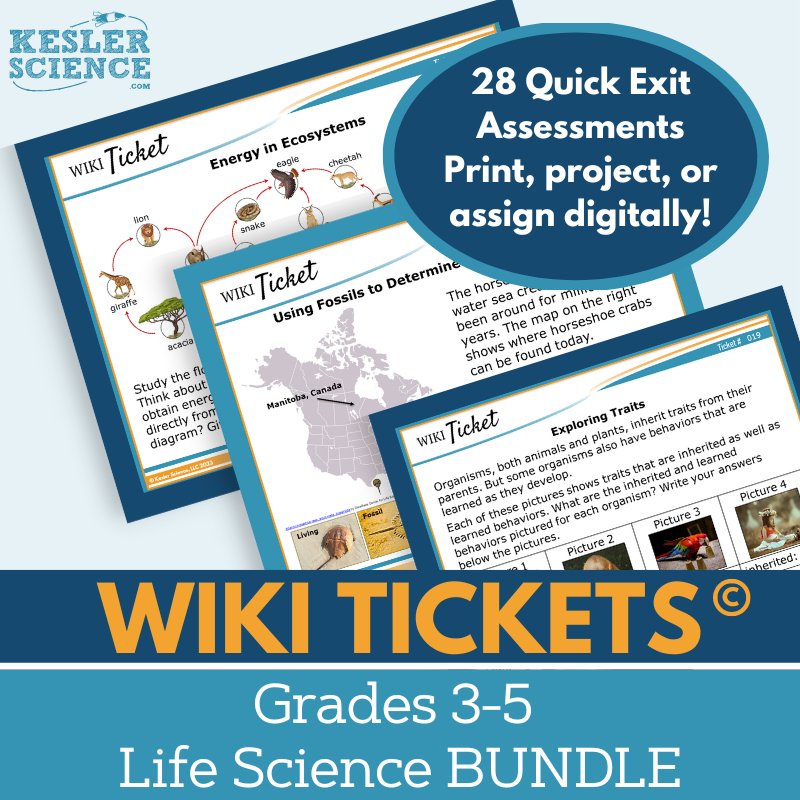Structures & Functions of Plants Activities for 4th Grade Science
This 4th-grade life science lesson, aligned with TEKS 4.13A, teaches students how plant structures like waxy leaves and deep roots help plants survive. It includes editable PowerPoints, worksheets, assessments, and student-choice projects, suitable for in-class and virtual learning. Using the 5E Model, students explore plant structures through differentiated station labs, hands-on activities, and research. They demonstrate learning through writing and illustrating tasks, with a bonus "Challenge It!" station for early finishers. The lesson also features interactive notebooks, choice projects, and updated assessment questions aligned with STAAR 2.0. The resources below will give students a comprehensive understanding of plant structures and functions. All of the following materials are also included in the Kesler Science Membership.
This life science lesson for 4th graders explores how plant structures and functions, such as waxy leaves and deep roots, help plants survive in their environment. The lesson includes editable PowerPoints, worksheets, assessments, and student-choice projects, all aligned with the 2021 TEKS 4.13A standard. It offers differentiated, student-led learning with minimal prep and is suitable for both in-class and virtual settings.
The unit follows the 5E Model: Engagement, Exploration, Explanation, Elaboration, and Evaluation. During the Exploration phase, students engage with nine differentiated station labs, exploring plant structures through hands-on activities, reading, research, and videos. They demonstrate their learning through organizing, writing, and illustrating activities, with a bonus "Challenge It!" station for early finishers.
The Explanation phase includes editable PowerPoints and interactive notebooks, with templates in English and Spanish to support note-taking. For Elaboration, students complete choice projects that extend their learning. The Evaluation phase offers updated assessment questions aligned with STAAR 2.0, plus review materials for practice.
This life science lesson for 4th graders explores how plant structures and functions, such as waxy leaves and deep roots, help plants survive in their environment. The lesson includes editable PowerPoints, worksheets, assessments, and student-choice projects, all aligned with the 2021 TEKS 4.13A standard. It offers differentiated, student-led learning with minimal prep and is suitable for both in-class and virtual settings.
The unit follows the 5E Model: Engagement, Exploration, Explanation, Elaboration, and Evaluation. During the Exploration phase, students engage with nine differentiated station labs, exploring plant structures through hands-on activities, reading, research, and videos. They demonstrate their learning through organizing, writing, and illustrating activities, with a bonus "Challenge It!" station for early finishers.
The Explanation phase includes editable PowerPoints and interactive notebooks, with templates in English and Spanish to support note-taking. For Elaboration, students complete choice projects that extend their learning. The Evaluation phase offers updated assessment questions aligned with STAAR 2.0, plus review materials for practice.
This student-led station lab aligns with the 2021 TEKS 4.13A standard on plant adaptations, including protection, defense, nutrient acquisition, and internal and external structures. The modular activities allow students to explore how plant structures and functions help them survive in their environments, offering a comprehensive, low-prep solution for teachers.
The lab features nine differentiated stations where students engage with multimodal resources to deepen their understanding of plant biology. Stations include "Explore It!" where students apply knowledge, "Watch It!" for a short video on plant defenses, "Read It!" with differentiated readings in English and Spanish, and "Research It!" for students to connect facts, images, and graphs to their learning.
Students demonstrate their understanding at output stations like "Organize It!" for hands-on activities, "Illustrate It!" for drawing plant diagrams, and "Write It!" for short answer responses. The "Assess It!" station features task cards and vocabulary exercises. A bonus "Challenge It!" station offers extension activities for advanced learners.
This station lab is designed for both in-class and virtual learning environments, making it a versatile tool for diverse classroom settings.
This student-led station lab aligns with the 2021 TEKS 4.13A standard on plant adaptations, including protection, defense, nutrient acquisition, and internal and external structures. The modular activities allow students to explore how plant structures and functions help them survive in their environments, offering a comprehensive, low-prep solution for teachers.
The lab features nine differentiated stations where students engage with multimodal resources to deepen their understanding of plant biology. Stations include "Explore It!" where students apply knowledge, "Watch It!" for a short video on plant defenses, "Read It!" with differentiated readings in English and Spanish, and "Research It!" for students to connect facts, images, and graphs to their learning.
Students demonstrate their understanding at output stations like "Organize It!" for hands-on activities, "Illustrate It!" for drawing plant diagrams, and "Write It!" for short answer responses. The "Assess It!" station features task cards and vocabulary exercises. A bonus "Challenge It!" station offers extension activities for advanced learners.
This station lab is designed for both in-class and virtual learning environments, making it a versatile tool for diverse classroom settings.
The Structures & Functions of Plants Student Choice Projects align with the 2021 TEKS standard 4.13A for biology, offering 4th graders multiple project options to showcase their learning. The project page features six student-led choices and a “design your own” project, with a grading rubric that can be used by teachers, peers, or students. Teachers can modify the rubric to fit their specific grading needs. The projects are flexible and provide creative ways for students to demonstrate their understanding.
The resource includes nine project options plus a “design your own” project, a Teacher Directions page for support, and editable rubric pages assessing vocabulary, concepts, presentation, clarity, and accuracy. The projects require standard classroom supplies like paper, markers, and scissors, with many options available for digital completion. Differentiated versions of the project page cater to students needing remediation or challenge, while the same rubric can be applied across both versions.
The Structures & Functions of Plants Student Choice Projects align with the 2021 TEKS standard 4.13A for biology, offering 4th graders multiple project options to showcase their learning. The project page features six student-led choices and a “design your own” project, with a grading rubric that can be used by teachers, peers, or students. Teachers can modify the rubric to fit their specific grading needs. The projects are flexible and provide creative ways for students to demonstrate their understanding.
The resource includes nine project options plus a “design your own” project, a Teacher Directions page for support, and editable rubric pages assessing vocabulary, concepts, presentation, clarity, and accuracy. The projects require standard classroom supplies like paper, markers, and scissors, with many options available for digital completion. Differentiated versions of the project page cater to students needing remediation or challenge, while the same rubric can be applied across both versions.
The WIKI Tickets© formative assessments offer an engaging way to check student understanding in 3rd–5th grade science. This Life Science Set includes 28 assessments, each available in five formats: a full-screen projection version, three printable handout sizes, and an interactive digital version compatible with PowerPoint and Google Slides.
Aligned with NGSS and TEKS standards for upper elementary science, every standard is covered by at least one ticket, with some topics offering multiple options. A bonus table of contents file highlights the standards alignment.
These versatile assessments can be used in both in-person and virtual settings. Topics covered include animal groups for survival, changes in ecosystems, energy flow in food webs, inherited traits, internal and external structures, fossil evidence, and plant growth, among others.
WIKI stands for "What I Know Is." These colorful, flexible assessments can be used as exit tickets, bellringers, or quick checks for understanding. They can be projected, printed, or assigned digitally through PowerPoint or Google Slides, making them adaptable for any classroom environment.
The WIKI Tickets© formative assessments offer an engaging way to check student understanding in 3rd–5th grade science. This Life Science Set includes 28 assessments, each available in five formats: a full-screen projection version, three printable handout sizes, and an interactive digital version compatible with PowerPoint and Google Slides.
Aligned with NGSS and TEKS standards for upper elementary science, every standard is covered by at least one ticket, with some topics offering multiple options. A bonus table of contents file highlights the standards alignment.
These versatile assessments can be used in both in-person and virtual settings. Topics covered include animal groups for survival, changes in ecosystems, energy flow in food webs, inherited traits, internal and external structures, fossil evidence, and plant growth, among others.
WIKI stands for "What I Know Is." These colorful, flexible assessments can be used as exit tickets, bellringers, or quick checks for understanding. They can be projected, printed, or assigned digitally through PowerPoint or Google Slides, making them adaptable for any classroom environment.
Year-Round Resources
These year-round activities will increase your students' understanding of many middle school science topics. All of these activities are also included in the Kesler Science Membership.
Visual Data & Graphing
You're not alone if your students struggle with understanding graphs, charts, and tables. It's a skill that takes an enormous amount of practice. This resource will help students build a strong foundation in analyzing data and creating their own data visualizations.
Bell Ringers and Warm-Ups
These middle school science bell ringers are an excellent way to engage your students as soon as they walk into your classroom. This comprehensive FULL YEAR resource includes everything you need to start off each science class with an interesting warm-up activity.
Review Board Games
Each game board has been carefully designed to keep students engaged. There are 10 different action spaces on each board and dozens of question cards. All of the actions are related to science concepts and keep the students motivated throughout the game.
Each game is ready to play. Simply print out the board and the cards and let the students enjoy reviewing nine different units.
Essential Questions and Standards
Below are the essential questions and standards associated with the lessons and activities included in the atoms unit. This topic is only one of more than 100 middle school science topics included in the Kesler Science Membership.
-
How do the structures and functions of plants allow them to survive in their environment?
-
TEKS Science - 4.13A Structures & Functions of Plants
Kesler Science Membership
Imagine never having to search for another middle school science lesson again. The membership gives you access to ALL of the Kesler Science products in one place (Yes, including everything above).
Say goodbye to long hours of lesson prep.









